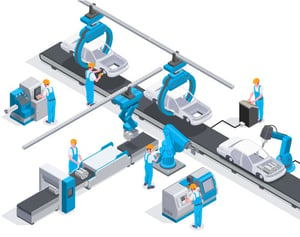It's no secret that developing products come with many challenges. Some of them are unpredictable, while others can be avoided with better planning and preparations. Issues often arise from internal factors, including miscommunication, information silos, and differing opinions. Some issues occur due to external factors, such as supply shortages or market demands.
As a product manager, you know your job can be challenging and demanding. You have to manage large portfolios, coordinate multiple teams, and have a lot of responsibility placed on your shoulders. But often, you're left with tools that make your job harder. Thankfully, there are tools that can help make new product development processes more efficient, such as product roadmap management (PRM) software. PRM software can save you time and energy while helping you ensure the products you oversee stay in alignment with your company's goals.
1. Managing Product Ideation
 The first stage of product development is product ideation. Generating ideas for products or new features can be a difficult task. There are many obstacles product managers must jump over, which can slow the whole process down, and most of them are internal factors. For example, product managers might lack knowledge about potential consumer needs, not because the research wasn't done but because they don't have ready access to the feedback. They may also require better communication tools to connect with their teams to discuss the viability of product ideas and limitations.
The first stage of product development is product ideation. Generating ideas for products or new features can be a difficult task. There are many obstacles product managers must jump over, which can slow the whole process down, and most of them are internal factors. For example, product managers might lack knowledge about potential consumer needs, not because the research wasn't done but because they don't have ready access to the feedback. They may also require better communication tools to connect with their teams to discuss the viability of product ideas and limitations.
In many cases, the biggest problems that arise in the product ideation phase can be solved by better tools that allow the sharing of data, real-time feedback, and a clear understanding of the company's priorities. Once internal communication is streamlined and data is better organized, these problems are greatly reduced. Cross-functional collaborations and a single source of truth for insightful data help prevent information silos and allow for better decision-making.
2. Initiating Market Viability Research
 Once an idea for a product is established, product managers need to see that the next stage is initiated. Product managers will need to send prototypes to the customer research teams to see whether a product is viable for the market before making any production decisions or commitments.
Once an idea for a product is established, product managers need to see that the next stage is initiated. Product managers will need to send prototypes to the customer research teams to see whether a product is viable for the market before making any production decisions or commitments.
Testing the product's viability might look like researching customer wants and needs or putting the test products in the hands of actual customers for their opinions. Since the ultimate focus of your product is to satisfy your consumer, product teams must gather detailed customer feedback, which can be time-consuming and demanding. Once this data is collected, it needs to be shared with relevant stakeholders. Product managers can struggle with getting this valuable information to other departments due to a lack of tools to share documents and reports. Using software that enables real-time collaboration and sharing data sets makes this step easier. Companies can make better decisions about their products and proposed features when everyone knows and understands what the customer wants.
3. Product Plan Roadmap Issues
 When products are approved for development, the path to getting that product made and released to its intended market is the product roadmap. Manufacturers have multiple roadmaps in any given product line that need constant oversight and analysis. This can be a challenge if you're using multiple tools for managing your roadmaps.
When products are approved for development, the path to getting that product made and released to its intended market is the product roadmap. Manufacturers have multiple roadmaps in any given product line that need constant oversight and analysis. This can be a challenge if you're using multiple tools for managing your roadmaps.
Product Roadmap Management software is meant to provide high-level oversight for entire product portfolios with clear, easy-to-understand visuals. With PRM tools such as Gocious, product managers can switch from high-level dashboard views to focused views on individual product lines. Fewer problems with roadmaps arise when managers can find all the information they need in one central location.
4. Communication and Collaboration Management
 Effective collaboration between teams is crucial for a productive workflow, and communication is essential to collaboration. The way your teams work together plays a significant role in the overall function of your company. For a PM to create products that align with company goals, they must work closely with the project managers so that the workflow of the product runs smoothly.
Effective collaboration between teams is crucial for a productive workflow, and communication is essential to collaboration. The way your teams work together plays a significant role in the overall function of your company. For a PM to create products that align with company goals, they must work closely with the project managers so that the workflow of the product runs smoothly.
Having the right tools available for product stakeholders can help extensively. PRM software is the key to reducing the need for unnecessary meetings, creating collaborative documents, and keeping information out of silos. Through PRM software, product managers can integrate information with other systems within the company or business, making the process more efficient and allowing opportunities for greater automation.
5. Engineering Delays
 The development of a product can also run into engineering issues, including product delays or missing milestones. If your engineering team misses a deadline or is behind schedule, this will affect other product teams whose work depends on the completion of the engineering plans. Another issue that could arise is when your engineers inform your design team that their ideas are not feasible. This results in delays where the design team must reconfigure their idea.
The development of a product can also run into engineering issues, including product delays or missing milestones. If your engineering team misses a deadline or is behind schedule, this will affect other product teams whose work depends on the completion of the engineering plans. Another issue that could arise is when your engineers inform your design team that their ideas are not feasible. This results in delays where the design team must reconfigure their idea.
Collaboration and effective communication are vital to avoid issues like these. Cross-functional meetings make it easier to keep engineering teams informed and provide updates on their progress. PRM software helps connect all your teams by sharing reports and facilitating real-time communication. With PRM software, product managers can better manage delays and problems, regardless of which team is affected.
6. Time-to-Market
 The ability of your team to produce products quickly can determine the position of the product in the market. Meeting deadlines and launching timelines is an extremely important aspect of product management and requires close collaboration with project managers.
The ability of your team to produce products quickly can determine the position of the product in the market. Meeting deadlines and launching timelines is an extremely important aspect of product management and requires close collaboration with project managers.
There are a number of issues that can affect the time-to-market of a product that product managers have no control over. This can include issues such as unforeseen supply problems, legacy systems, or labor delays. However, PRM software can help make it easier to plan and map out production, so it takes less time to go from the idea phase to the launch phase.
7. Lack of Support for Product Managers
 The work of a product manager can be extremely rewarding and interesting, but it can also be immensely stressful and difficult at times.
The work of a product manager can be extremely rewarding and interesting, but it can also be immensely stressful and difficult at times.
Often, product managers lack the support and tools to do their jobs effectively. With the right software, much of the stress of coordination and communication can be reduced. PRM software gives PMs all the tools they need to effectively manage their teams and see the products to life.
The One Tool All Product Managers Need
Software designed for manufacturing helps product managers make better decisions about products by having access to all the data they need in one central location. Gocious makes it easy to monitor, analyze, and revise product roadmaps. Book your free demo with Gocious to see how it can work for your company.


